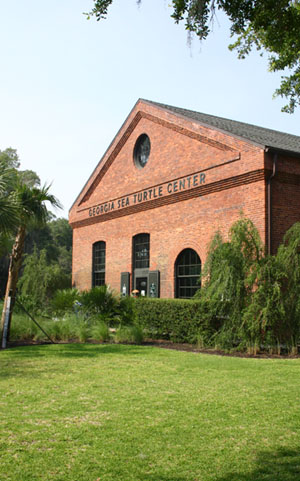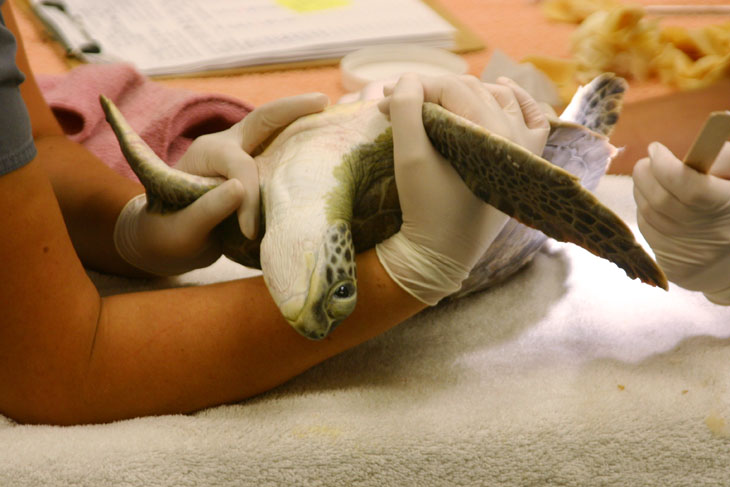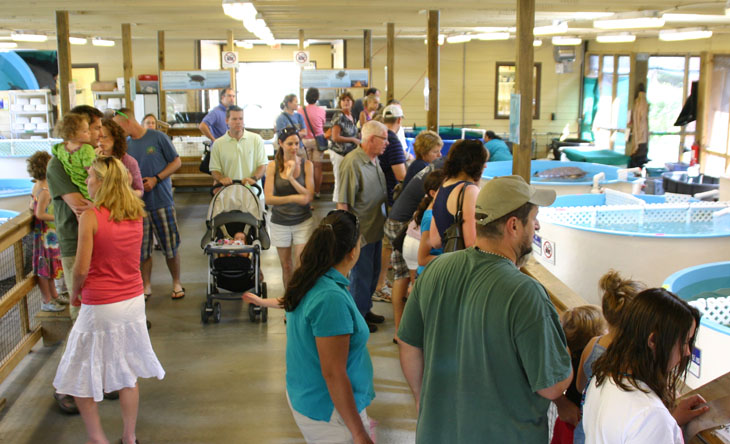I’m back from the trip, having extended the stay by a few days, and found that you all began tearing up the comments while I was away. I guess I expected no less.
 The Girlfriend and I spent some time with friends in the Savannah, Georgia area, and got around a bit to check out some interesting items in the vicinity. The first thing we visited, and thus the first I’ll talk about, is the Georgia Sea Turtle Center on Jekyll Island. Having worked with wildlife rehab and visited several centers devoted to such, I can easily say this was the most impressive, and well worth a visit if you’re within even a few hours of the area. If you’re into turtles or wildlife, involved with rehab in any way (even as a donor,) or simply want to see something different, this should be on your list.
The Girlfriend and I spent some time with friends in the Savannah, Georgia area, and got around a bit to check out some interesting items in the vicinity. The first thing we visited, and thus the first I’ll talk about, is the Georgia Sea Turtle Center on Jekyll Island. Having worked with wildlife rehab and visited several centers devoted to such, I can easily say this was the most impressive, and well worth a visit if you’re within even a few hours of the area. If you’re into turtles or wildlife, involved with rehab in any way (even as a donor,) or simply want to see something different, this should be on your list.
Started just a few years back in 2006, the center is housed within the old power station buildings for the island, through the cooperation of the Jekyll Island Foundation, which maintains the historic portions of the island. The Foundation recognized the attraction of a decent public wildlife center, as well as the need to educate people on the species that routinely nest on the beaches. But there’s more to it than that, too, since the Georgia Sea Turtle Center is far in advance of any rehab or education center I’ve visited save for the NC Zoological Park, and it’s obvious a lot of emphasis has been placed on the outreach portions of their mission. I can’t stress enough how important this is; non-profit organizations run on public support, and the only way one can forge ahead with funding is by creating and maintaining a compelling public presence. I can’t tell you how many people I’ve talked to that think that directing their funds towards development and education would take money from actual rehabilitation services, and this is complete nonsense, bordering on the ignorant. Development funds are an investment that, properly managed, pays back hugely, and this center is a prime example of how it works. This is evident even before you enter the building, from the parking lot with bus unloading areas to the “Walkway to Wonder” brick entrance, positively loaded with engraved messages from donors.
Inside, the education area has plenty of interactive and engaging exhibits, and as a model-builder, I can vouch for the effort that went into these. The entrance ticket serves as a prompt to have visitors check out stations around the hall, receiving an embossed seal from each that reveals another aspect of turtle life – it’s amazing how much attraction such a simple thing like a surprise seal provides, since there are multiple unrevealed embosser choices at each station. Big screen TVs roll video loops of excellent footage, including such things as testing of turtle excluders in commercial fishing nets (a real example of which stretches overhead in the vaulted ceilings of the old power station,) and the sand writhing as newborn turtles emerge from buried nests and make their frantic way to the ocean.

But to one side sits the observation window, where visitors can observe the rehabilitation technicians and veterinarians actually administering to patients in the adjoining medical room. Because turtle eyes are sensitive to bright light, there is no flash photography permitted, so be prepared and boost your ISO a bit to allow sharp images. The staff throughout the center are not only helpful, they’re directly engaging, offering advice and interesting tidbits as well as taking a distinct interest in the visitors. Even the rehab technicians will bring patients up the the glass for a brief good look before returning them to their housing. Little things like that do a lot for creating a positive experience, as opposed to the demeaning and snotty attitudes I’ve seen from some rehabilitators, who seem to feel the public is just there to make them suffer. No, seriously, this is a trait I’ve encountered frequently. The “public,” either through indifference or well-meaning ignorance, does indeed contribute to lots of wildlife issues, but for some reason many rehabbers seem to think this is intentional, and take it personally. If this is your attitude, let me help you out right now: get the hell out of the business. The “public” is what makes wildlife rehab actually work, and annoying them isn’t going to gain any funding. It’s nice to be at a place where they recognize this.

Attached to the main building sits the big enclosed pool area. Sea turtles, naturally, need large tanks of clean and maintained water to recover within, and the Georgia Sea Turtle Center provides a public hall down the center of their facility to let visitors see the patients. More clever touches were evident here: mirrors were set above some of the tanks, allowing a better view of the residents, and the education interns are fitted with microphones wired into a PA system (or if you’re British, a tannoy) that could be heard throughout the chamber. Each tank bore the resident’s name, and info stations on the rails provided the background of their injuries and treatments. Questions were welcome and encouraged, and the raised platform allowed a little better visibility of the patients. We were lucky enough to be there for the feeding time presentation, which a staffmember kindly alerted us to. The fee for all of this, by the way, is less than you’d spend for lunch.
 Even the gift shop is impressive. Nicely laid out and with a wide variety of interesting items, from t-shirts and decals to fantastic artwork, it’s another aspect that shows what a bit of effort can do for a center. Proceeds, of course, go towards funding the center and its efforts, so even somewhat unreasonable prices are excusable, but actually the items were very competitively priced. Even here, the staff noticed visitors’ interests and volunteered pricing information or fetched an item to be examined. Sometimes little things like this go unnoticed, and I want to emphasize that it’s a nice touch, and I’m pleased with their attention to this.
Even the gift shop is impressive. Nicely laid out and with a wide variety of interesting items, from t-shirts and decals to fantastic artwork, it’s another aspect that shows what a bit of effort can do for a center. Proceeds, of course, go towards funding the center and its efforts, so even somewhat unreasonable prices are excusable, but actually the items were very competitively priced. Even here, the staff noticed visitors’ interests and volunteered pricing information or fetched an item to be examined. Sometimes little things like this go unnoticed, and I want to emphasize that it’s a nice touch, and I’m pleased with their attention to this.
Since we were visiting the area briefly, we didn’t get to see any of the educational programs, or take part in a turtle walk – the center does not stand alone. But we’ll definitely be returning, and in the meantime, I can only urge you to check it out, most especially if you’re involved with wildlife rehab in any way. Make sure you thank the staff you see there, too – non-profit organizations don’t exactly provide competitive salaries, and most people working there are volunteers. But it’s through their dedication and efforts that such centers exist, and a lot of turtles owe their health and well-being to this drive. And by all means, check out the website, which also reflects this effort.
A lot of the images I shot on this trip are actually on film, so more details about what we got up to will wait on the processing (I ship it out since the local labs have stopped handling slide film.) As a teaser, I can just say that it’s good to go back to the sub-tropics from time to time.



















































